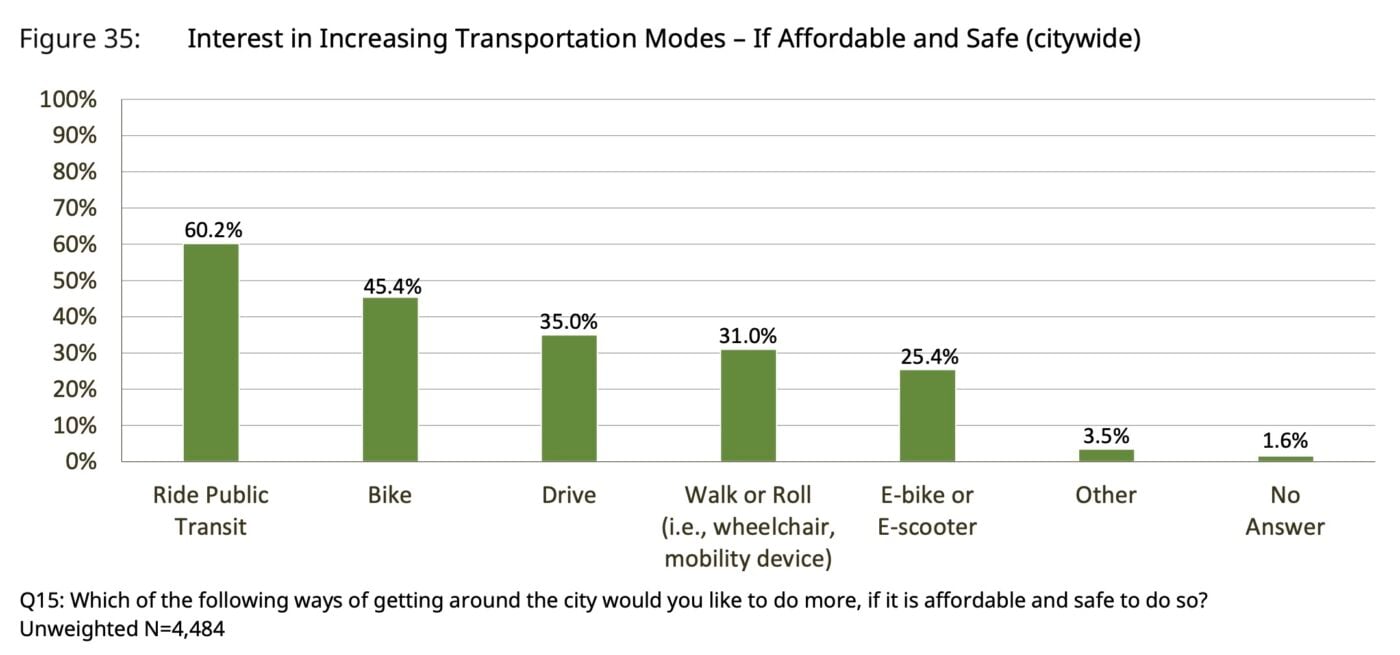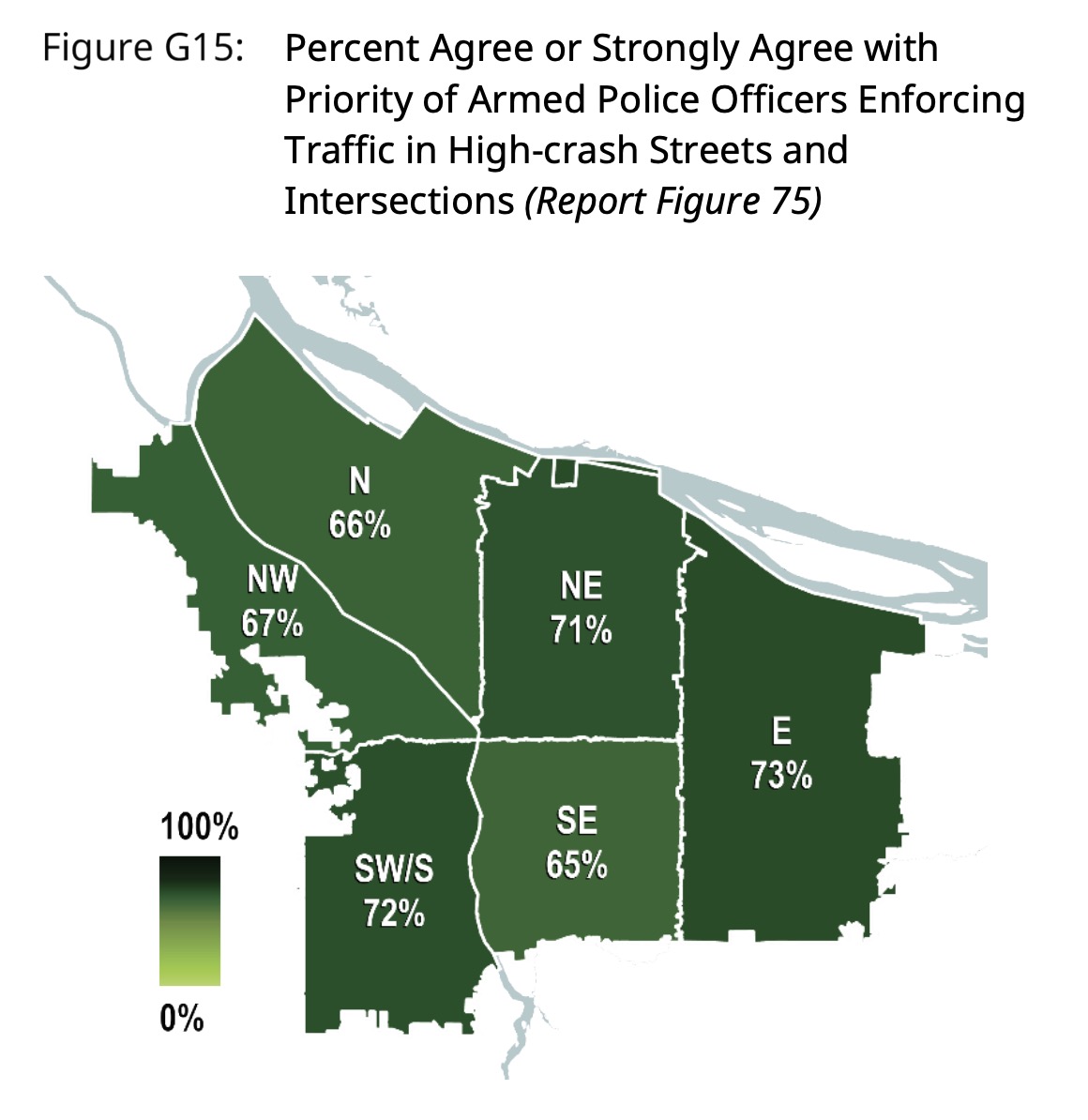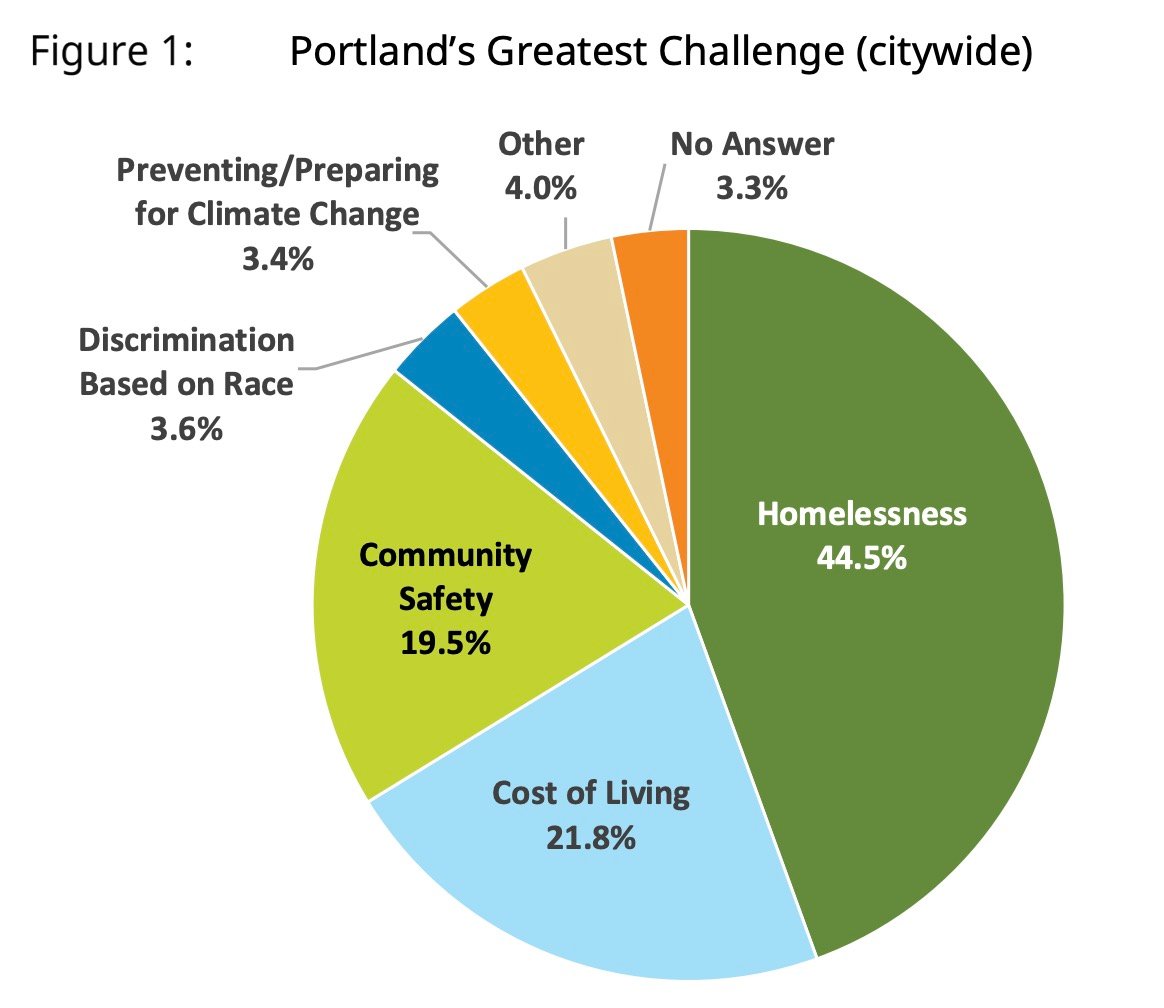 Portland’s future, if we want it. (Photo: Jonathan Maus/BikePortland)
Portland’s future, if we want it. (Photo: Jonathan Maus/BikePortland)
There’s strong potential for biking and transit use in Portland if people felt it was safe and affordable, most Portlanders want more armed police officers to enforce traffic laws, and fighting climate change isn’t even a top three priority given the other crises our city faces — those are just three takeaways from a major new survey completed by the City of Portland.
The 2022 Portland Insights Survey was a collab between the City Budget Office and a research institute at Portland State University. It’s based on 5,290 completed surveys that gleaned both quantitative and qualitative responses on six subjects. Many of the findings are relevant to transportation issues. And with the responses broken down by geography and race/ethnicity, we now have a new set of data to understand how Portlanders feel about a variety of issues.
Below are what I felt are the key takeaways…


Just make transit and cycling safe, and Portland could be well on its way to meeting lofty transportation goals. One of the survey questions asked, “Which of the following ways of getting around the city would you like to do more, if it is affordable and safe to do so?” (Respondents could choose more than one answer.)
Citywide, 60.2% of respondents said they’d ride public transit more often. And second place was “bike” with 45.4%. “Drive” finished in third at 35%, followed by “walk or roll” at 31%.
That bike number is likely much higher, because (for some strange reason), the survey put “e-bike” in a combined category with “e-scooter.” Given what we know about the popularity of e-bikes and relatively small amount of e-scooter fans in Portland, I would wager the combined “bike” and “e-bike” response to this question would put cycling well over 50%.
These responses were similar across all sections of the city, except for east Portland. That is the only sextant where people ranked “drive” as the top mode they’d like to do more of if they felt like it was safer and cheaper. In east Portland, 55.2% of respondents picked “drive,” followed by transit at 49.3% and bike at just 30.6%. Also notable is that the percentage of respondents who said they’d bike more was nearly twice as high in southeast (58.3%) as in east (30.6%).
I’ve alluded to this problem before, but we must understand and grapple with the fact that a perfect storm of factors is leading a large number of Portlanders to express negative views of cycling infrastructure. Regardless of the accuracy or true feelings behind these sentiments, they are loud and increasingly being heard at City Hall, PBOT, and by the local media.
Even the report’s own summary states, “… car traffic patterns that cater to bikes and bike traffic (when bikes are not seen very often), have, at times, increased the difficulty in accessing businesses and decreased sidewalk safety.”
And the report shares dozens of “representative quotes” from Portlanders, with a striking number of them saying bad things about bike-related infrastructure:
“To pay all that [in taxes] and roads are terrible with costly, fancy bike lanes everywhere…”
“Recent ‘improvements’ to this neighborhood’s roads are a total waste of money. We need sidewalks because there are tons of walkers especially with dogs … we don’t need designated bike lanes as many are elderly. And now we have an area with shared lanes to accommodate bikes, which are few and far between. You have eliminated parking for some homes and the lines are confusing.”
“PBOT needs to stop converting streets to bicycle only avenues.”
On the flip side, the report also had quotes about transportation that express the need to make biking and walking better:
“As a senior who grew up in Portland and has many times used Max to join up with friends all over the city, as a person who has rode my bike from home to many activities in city parks, as a person who has many times walked to do my grocery shopping, I am saddened to not feel as comfortable doing these activities. I know that not all homeless use drugs, but I can’t tell who is so I keep my distance with them all.”
“I approve of the improvements to Division and Powell, but [where] I live – I cannot walk to our closest convenience store without having to walk in the street because we don’t have sidewalks”
“Cars have no front license plate, run red lights, drive in bike lanes, don’t stop for pedestrians and speed like crazy. State transportation is focused on expanding highways in town with support of the city while state owned highways like Powell, etc. remain incredibly dangerous.”
“As a bicyclist, I am grateful for and thoroughly enjoy all of the bike lanes & paths, however the number of vehicles that do not have license plates/current tags or even valid trip permits, is terrifying, especially when the driving is often aggressive and erratic.”
“Insufficient crosswalks throughout the city.”
And my favorite comment by far:
“Portland needs to upgrade its public transit system and stop inducing traffic by widening roads. Widening roads also has the side effect of increasing pollution, increasing noise pollution, and making the city less walkable and bikeable. As long as public transit is slow as molasses, people will continue to choose to drive. Full stop. This is why we need modern high-speed public transit, not half-measures that waste tax dollars and do nothing to attract drivers onto public transit. Our MAX lines are based on ancient technology and it takes forever to travel across town. There are so many possibilities available to us. If we want to, we could create underground railways that connect key areas of Portland via modern trains that reach 150+ MPH. Why are we not doing this?”
When Portland passed its Vision Zero plan in 2015, one of the (sort of controversial) decisions was that it did not place a priority on police enforcement of traffic laws. An advisory committee recommended the policy due to fears of racial profiling and over-policing of neighborhoods where a larger amount of BIPOC and lower-income Portlanders live. That sentiment was embraced by PBOT during the 2020 protest era as they ended an enforcement partnership with the Portland Police Bureau and the agency chose to dissolve its Traffic Division five months later.
But now, given the dire state of our street culture and record deaths, this survey reveals that many Portlanders want more armed police involved in traffic enforcement.
Citywide, only 6.3% of respondents said they do not want police to enforce traffic laws around high-crash streets and intersections. 68.6% of all respondents to this question (“In addition to responding to 911 calls, how should armed police officers prioritize their response to the following situations? Traffic enforcement in high-crash streets and intersections (use photo/radar van and police missions to reduce speeding and red-light running, etc.”) said it should be a high priority (33.6%) or medium priority (35%). For context, the number of people who said police involvement in traffic enforcement should be a high priority was about half as high as the number of people who want police to respond to reports of crimes (60.7%).
Interestingly, the responses to the traffic enforcement priority question from Black and white people were very similar (see below). While white people said “Do not want police to do this” at a rate twice as high as Black people (6.7% and 3.3%, respectively), overall their responses were nearly identical.
In some ways, walking is the most form of travel where a person is most vulnerable. According to this survey, only one in five east Portland residents feel safe walking in their neighborhood at night. That is a very low number that we should all care about. And only two of the sextants had a number that was over 50% (southeast and southwest/south).
When it comes to whether people feel safe walking in their neighborhood during the day, we see another vast discrepancy between east and southeast — 55% versus 84%. Broken down by race/ethnicity, again we see that white (77.8%) and Black (70.7%) Portlanders had similar perceptions about safety. But for Asian respondents, that number was only 58.1%.
How people feel about walking in their neighborhood is one of the most important measures of how successful a city is. It encompasses so many factors around livability, transportation, and general safety. I’m eager to see how this number changes in future years.
When asked, “What is the greatest challenge facing Portland?” just 3.4% of respondents chose “Preventing/Preparing for Climate Change.” Given the existential threat and very real consequences of the climate crisis, this seemed like an extremely low number. But when up against other very real, daily threats people feel from homelessness, the cost of living, and community safety (the top three answers), it is understandable.
This response is a good illustration of how Portland’s inability to tackle those Big Three problems (homelessness, affordability, and crime), means that we have very little personal or political capacity left over to deal with anything else.
One last little tidbit that caught my eye was that only about 10% of respondents said they think it’s easy to contact city government about important issues. That is abysmal. We can only hope that the massive change coming to our government structure in 2025 will change that.
The City of Portland plans to conduct this survey once every two years. And most of the questions will remain the same so we can see changes over time. City Council is discussing the report at their meeting today. See the full report here.






